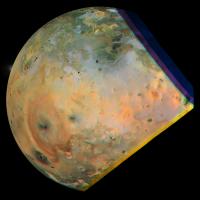Printable Version of Topic
Click here to view this topic in its original format
Unmanned Spaceflight.com _ Jupiter _ Io's color: Image processing experiments
Posted by: Bjorn Jonsson Jul 16 2013, 04:37 PM
This is an experimental color composite of Io from Voyager 1 images:
In this image the red color of the terrain around Pele is more obvious than in other versions of this image where it is not so obvious, for example this one:
http://photojournal.jpl.nasa.gov/catalog/PIA00010
The red terrain on Io is brighter at red wavelengths than shorter wavelengths but apart from this it is spectrally not too different from e.g. the yellow terrain. Unlike Galileo, Voyager didn't carry a red filter so it didn't clearly detect the red terrain. But it actually detected some hints of it since the Voyager orange filter includes a part of Io's spectrum where the albedo is starting to increase with wavelength. A graph showing Io's spectrum together with the spectral response of the Voyager filters can be seen on this excellent page by Jason: http://www.gishbartimes.org/2010/08/exposing-ios-true-colors.html
So I decided to try making a synthetic red image from the Voyager data. I started by making a ratio image: Orange/Green. This ratio image revealed clear hints of the red material around Loki. I then processed it to make a synthetic Red/Green ratio image using Galileo images as a guide. It was difficult to get a ratio image that had uniform accuracy across the entire image so the emhasis was on the Loki area. The result was a noisy Red/Green synthetic image that I smoothed quite a bit before multiplying it with the green image. The result was a fairly noisy synthetic red image.
There were some additional processing steps but I got the final color by interpolating a spectrum consisting of data from orange, green, blue and violet images plus synthetic red. The result was a somewhat noisy image where I manually fixed the worst artifacts in Photoshop. I don't think the resulting image shows Io's true colors accurately but the red terrain around Loki is an obvious and almost certainly real feature. The plume was processed separately and its brightness exaggerated.
This is work in progress. The Red/Green image can probably be improved a lot. I'm suspicious of the yellow/orange color of southern Colchis Regio, some of the small, red features may not be real even though they look realistic (there is an example of this WNW of Prometheus) and the polar regions look weird.
The original images I used were obtained on March 5, 1979 near 01:00 at a range of 500,000 km. This observation included lot of filters: UV, VI, BL, GR and OR.
Posted by: nprev Jul 17 2013, 05:50 AM
Beautiful work as always, Bjorn. ![]()
Rank amateur question: Given that Io's surface is inherently extremely colorful, is it somewhat easier to balance than imagery of other worlds with more subtle color variations?
I know that there are a great many other factors at work here, but curious about the filter of human subjectivity.
Posted by: JohnVV Jul 18 2013, 05:30 AM
QUOTE
but curious about the filter of human subjectivity
that has a rather large range of things
and it changes
a few years back i posted a Io map -- and it was a bit too blue
if this came through a photo lab on film i would print it something like this
as a 8x10 from a 35mm, 6x7cm , or 4x5 in
2048x1024 image
http://imgbox.com/adm2mAZK
now some might say that the yellow is a bit too unsaturated , and they might be right
different people will like different things
Posted by: Bjorn Jonsson Jul 18 2013, 05:21 PM
Rank amateur question: Given that Io's surface is inherently extremely colorful, is it somewhat easier to balance than imagery of other worlds with more subtle color variations?
On the contrary - Io is more difficult than most other worlds if you want accurate color. For example you simply need red images to get good results (near-IR works fairly well though) whereas for the other Galileans you can get fairly good results using orange as the longest wavelength. If the longest wavelength image you have of Io is orange (or shorter) you'll have big problems with Io's red areas (the starting post in this thread should show this). In general, Io's spectrum isn't as 'flat' as the spectrum of the other Galileans and this makes color image processing more difficult.
Powered by Invision Power Board (http://www.invisionboard.com)
© Invision Power Services (http://www.invisionpower.com)

